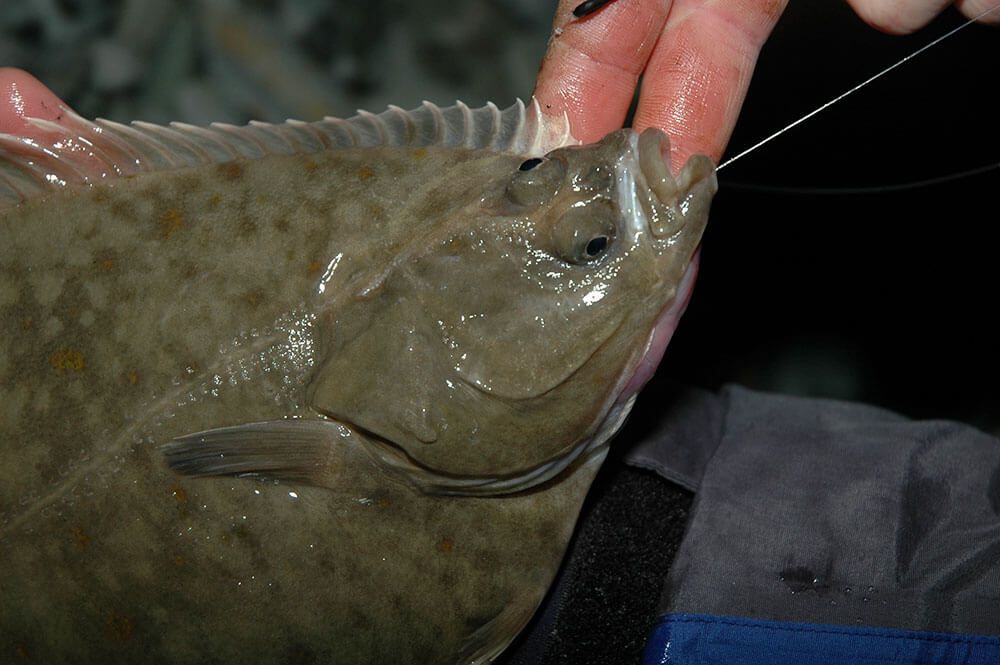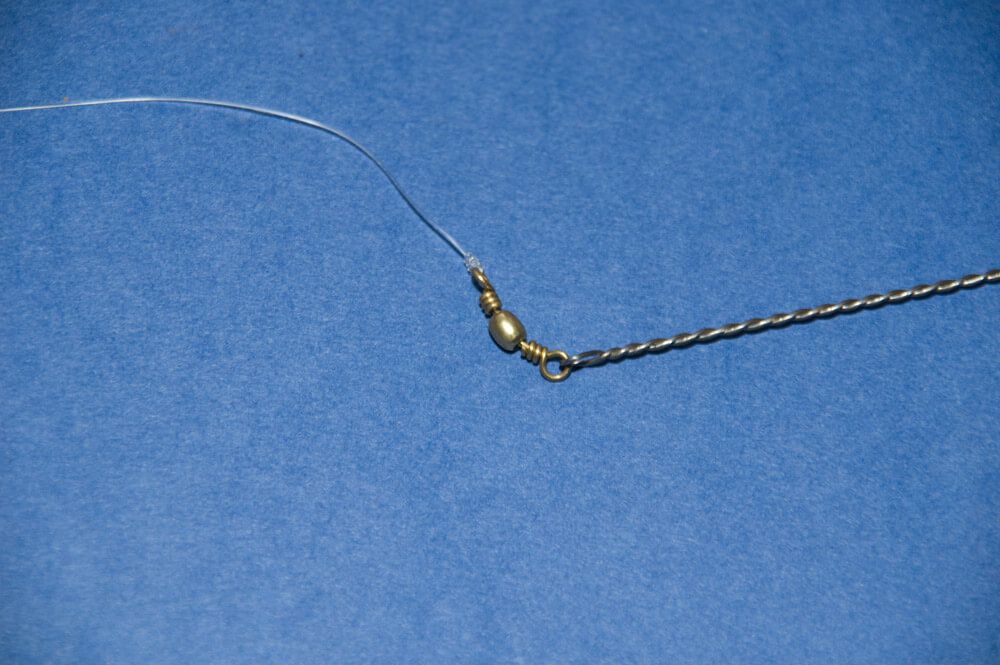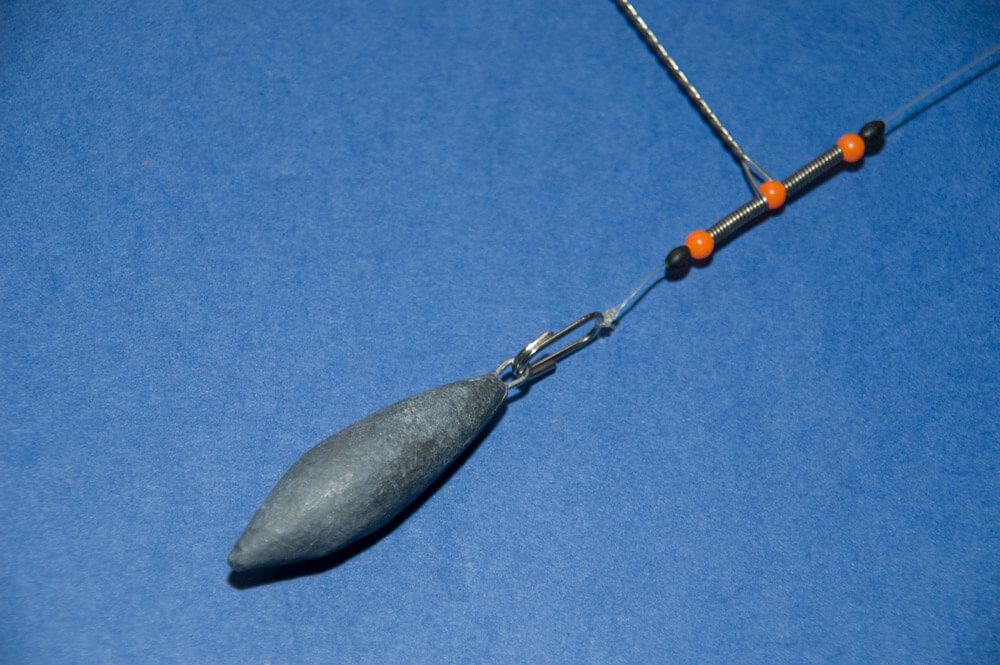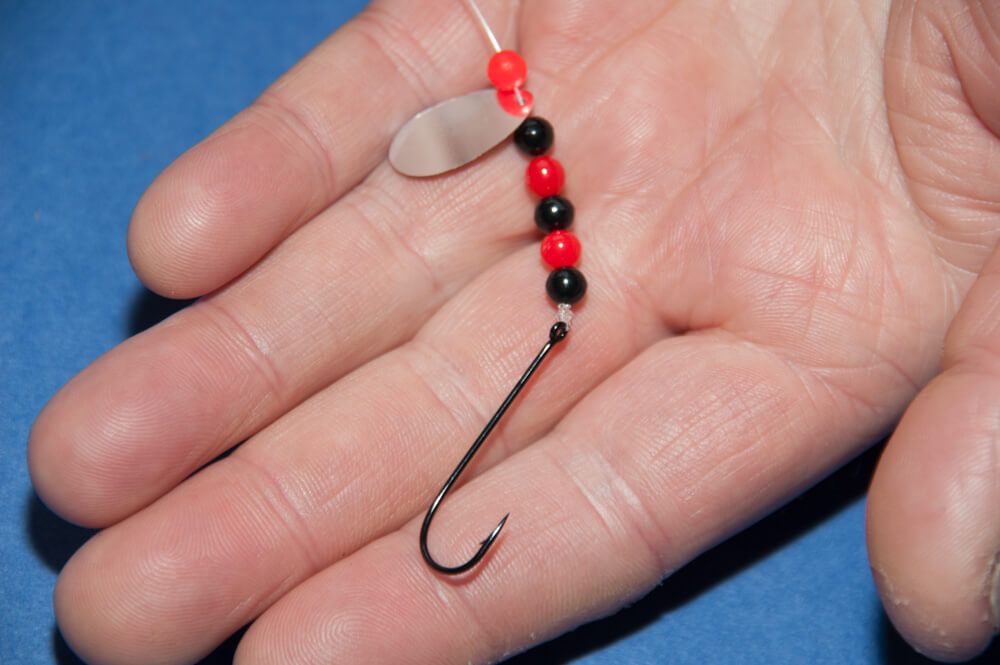You rarely see wire booms for shore rigs in tackle shops nowadays, and it’s even rarer to read about them in the monthly magazines. Also, chatting to other anglers on the beach, you rarely see them in use either.
This surprises me as I always have made up rigs utilising wire booms in my rig wallets and always carry a few spare wire booms in my tackle box to make up additional rigs if need be.
Plastic booms are popular and are often talked about, but wire booms have their place in current fishing, and if you know when and where to use wire booms they’ll add more fish to your overall catch, plus save you from a few blank days too.
One advantage with a wire boom is that the wire being stiff and used in conjunction with short 6 to 9-inch hook snoods you have a non tangle rig for fishing in tight amongst the surf tables. Presenting a bait on a short hook snood means that it has limited movement and in bumpy sea conditions when the seabed is scoured by passing waves. Baits being constantly washed around in the surf are not easy for say a flatfish to pin down, but the short travel of a bait presented on a short hook snood gives the fish a more static bait target to hit. The easier it is for the fish to find the bait, the easier it is for them to eat it.
Vibration may also be a factor. There’s a theory that tide moving over different surfaces gives off different vibrations. Obviously there would be a big difference in the vibes given off between tide over plastic and tide over metal. This especially applies to the wire booms that are formed by twisting two or more wires together. This forming action creates ripples or hollows in the wire arm which, as the tide passes through, must create more vibration that fish could potentially pick up through their lateral lines.
The biggest advantage with wire booms is their weight increase over traditional plastic booms. When fishing plastic booms if you use a three boom rig it’s really only the boom closest to the lead weight that is truly on the seabed and presenting the bait there unless you fish a few feet of slack line between the rod tip and the lead weight. However the increase in weight with wire booms means that with just a slight amount of slack line between the rod tip and the lead all three booms will be fishing on the seabed, even at short range.
What advantage does this give then? Well if the bottom boom is the only one catching it suggests that the other two are presenting the baits too far up in the water column. This is especially so when targeting flatfish. By switching to a three boom rig with wire booms, their added weight can put all three baits in amongst the fish. In a decent surf table pattern fishing plastic booms to a slack line may not be enough to keep the booms close to the seabed, but the wire ones will.
[caption id="attachment_15277" align="aligncenter" width="1000"] Wire booms can be effective for flat fish...[/caption]
Wire booms can be effective for flat fish...[/caption]
Also the weight of the wire boom means it’s less affected by a wave surge and therefore less prone to “lifting” in the water as the wave surge passes by. Plastic is much more buoyant and when fishing very small baits the boom lifts or cantilevers upwards as the surge passes through. In calm seas getting movement in to a bait can be an advantage and the plastic boom will score over the wire, but in rougher seas the weight of the boom is better as it keeps the bait closer to the seabed.
A problem that can occur with wire booms is that when a fish is hooked the hook snoods can twist up as the fish turns in the tide and fights. Small flatfish, whiting and rockling seem particularly prone to causing this, especially if they are hooked but the bite goes unnoticed for a few minutes but before you retrieve. However if you shop around you’ll find some wire booms available are sold with small swivels positioned inside the eye of the wire boom arm. These turn to the pressure of the spinning fish and massively reduce any potential twist in the snood line.
[caption id="attachment_15465" align="aligncenter" width="1000"] Swivels inside the boom eye massively reduce any potential twist in the snood line...[/caption]
Swivels inside the boom eye massively reduce any potential twist in the snood line...[/caption]
Just as with my plastic boom rigs I prefer to have the wire booms moveable by positioning them between beads and sliding stop knots or rubber rig stops. Sakuma also do excellent crimps with inner sleeves that allow the crimp to semi close and semi pressurise the line to make a moveable stop.
If you fish long beachcasters or a long European style rod, then you can make rigs with booms on up to 12-feet or more for close in fishing and this allows you to spread the booms well apart if the booms are moveable. This does two things, it covers a greater area of ground, but also widens the scent trail from the baits helping to pull fish in from a wider area even though the scent trail is weaker. This is a classic scratching tactic during the slow months of February, March and April.
There is another rig I use that I sussed from watching the American crank baits that use a boom with a spinner attached and prove so effective for pike, zander and perch in freshwater.
I set a single boom up and fix it between fixed crimps tight behind the lead weight link. To the booms eye attach 30-inches of 20lb clear Fluoro carbon. Slide on black bead, then a small plastic silver spoon, then 4 more alternate black and red beads. This is simply cast out in to the surf tables, or in to estuary creeks and channels, and slowly retrieved. This will catch flounders, plaice, school bass and lesser weevers amongst others.
[caption id="attachment_15464" align="aligncenter" width="1000"] Fix the boom just behind the lead link...[/caption]
Fix the boom just behind the lead link...[/caption]
[caption id="attachment_15466" align="aligncenter" width="1000"] Spoons and beads can be deadly in suft tables and estuaries...[/caption]
Spoons and beads can be deadly in suft tables and estuaries...[/caption]
The stiff wire boom in the above rig does not give as the spoon is retrieved, plus it dips in to the sand causing a fair amount of sand to be disturbed. This sand disturbance will pull in inquisitive fish that then see the moving bait and pounce. It’s a very simple way to fish, but is highly effective.
If you haven’t considered fishing wire boom rigs in the past, then reconsider because they give you a lot of advantages and in the right conditions will out fish standard and plastic boom rigs three to one.
This surprises me as I always have made up rigs utilising wire booms in my rig wallets and always carry a few spare wire booms in my tackle box to make up additional rigs if need be.
Plastic booms are popular and are often talked about, but wire booms have their place in current fishing, and if you know when and where to use wire booms they’ll add more fish to your overall catch, plus save you from a few blank days too.
One advantage with a wire boom is that the wire being stiff and used in conjunction with short 6 to 9-inch hook snoods you have a non tangle rig for fishing in tight amongst the surf tables. Presenting a bait on a short hook snood means that it has limited movement and in bumpy sea conditions when the seabed is scoured by passing waves. Baits being constantly washed around in the surf are not easy for say a flatfish to pin down, but the short travel of a bait presented on a short hook snood gives the fish a more static bait target to hit. The easier it is for the fish to find the bait, the easier it is for them to eat it.
Vibration may also be a factor. There’s a theory that tide moving over different surfaces gives off different vibrations. Obviously there would be a big difference in the vibes given off between tide over plastic and tide over metal. This especially applies to the wire booms that are formed by twisting two or more wires together. This forming action creates ripples or hollows in the wire arm which, as the tide passes through, must create more vibration that fish could potentially pick up through their lateral lines.
The biggest advantage with wire booms is their weight increase over traditional plastic booms. When fishing plastic booms if you use a three boom rig it’s really only the boom closest to the lead weight that is truly on the seabed and presenting the bait there unless you fish a few feet of slack line between the rod tip and the lead weight. However the increase in weight with wire booms means that with just a slight amount of slack line between the rod tip and the lead all three booms will be fishing on the seabed, even at short range.
What advantage does this give then? Well if the bottom boom is the only one catching it suggests that the other two are presenting the baits too far up in the water column. This is especially so when targeting flatfish. By switching to a three boom rig with wire booms, their added weight can put all three baits in amongst the fish. In a decent surf table pattern fishing plastic booms to a slack line may not be enough to keep the booms close to the seabed, but the wire ones will.
[caption id="attachment_15277" align="aligncenter" width="1000"]
 Wire booms can be effective for flat fish...[/caption]
Wire booms can be effective for flat fish...[/caption]Also the weight of the wire boom means it’s less affected by a wave surge and therefore less prone to “lifting” in the water as the wave surge passes by. Plastic is much more buoyant and when fishing very small baits the boom lifts or cantilevers upwards as the surge passes through. In calm seas getting movement in to a bait can be an advantage and the plastic boom will score over the wire, but in rougher seas the weight of the boom is better as it keeps the bait closer to the seabed.
A problem that can occur with wire booms is that when a fish is hooked the hook snoods can twist up as the fish turns in the tide and fights. Small flatfish, whiting and rockling seem particularly prone to causing this, especially if they are hooked but the bite goes unnoticed for a few minutes but before you retrieve. However if you shop around you’ll find some wire booms available are sold with small swivels positioned inside the eye of the wire boom arm. These turn to the pressure of the spinning fish and massively reduce any potential twist in the snood line.
[caption id="attachment_15465" align="aligncenter" width="1000"]
 Swivels inside the boom eye massively reduce any potential twist in the snood line...[/caption]
Swivels inside the boom eye massively reduce any potential twist in the snood line...[/caption]Just as with my plastic boom rigs I prefer to have the wire booms moveable by positioning them between beads and sliding stop knots or rubber rig stops. Sakuma also do excellent crimps with inner sleeves that allow the crimp to semi close and semi pressurise the line to make a moveable stop.
If you fish long beachcasters or a long European style rod, then you can make rigs with booms on up to 12-feet or more for close in fishing and this allows you to spread the booms well apart if the booms are moveable. This does two things, it covers a greater area of ground, but also widens the scent trail from the baits helping to pull fish in from a wider area even though the scent trail is weaker. This is a classic scratching tactic during the slow months of February, March and April.
There is another rig I use that I sussed from watching the American crank baits that use a boom with a spinner attached and prove so effective for pike, zander and perch in freshwater.
I set a single boom up and fix it between fixed crimps tight behind the lead weight link. To the booms eye attach 30-inches of 20lb clear Fluoro carbon. Slide on black bead, then a small plastic silver spoon, then 4 more alternate black and red beads. This is simply cast out in to the surf tables, or in to estuary creeks and channels, and slowly retrieved. This will catch flounders, plaice, school bass and lesser weevers amongst others.
[caption id="attachment_15464" align="aligncenter" width="1000"]
 Fix the boom just behind the lead link...[/caption]
Fix the boom just behind the lead link...[/caption][caption id="attachment_15466" align="aligncenter" width="1000"]
 Spoons and beads can be deadly in suft tables and estuaries...[/caption]
Spoons and beads can be deadly in suft tables and estuaries...[/caption]The stiff wire boom in the above rig does not give as the spoon is retrieved, plus it dips in to the sand causing a fair amount of sand to be disturbed. This sand disturbance will pull in inquisitive fish that then see the moving bait and pounce. It’s a very simple way to fish, but is highly effective.
If you haven’t considered fishing wire boom rigs in the past, then reconsider because they give you a lot of advantages and in the right conditions will out fish standard and plastic boom rigs three to one.

